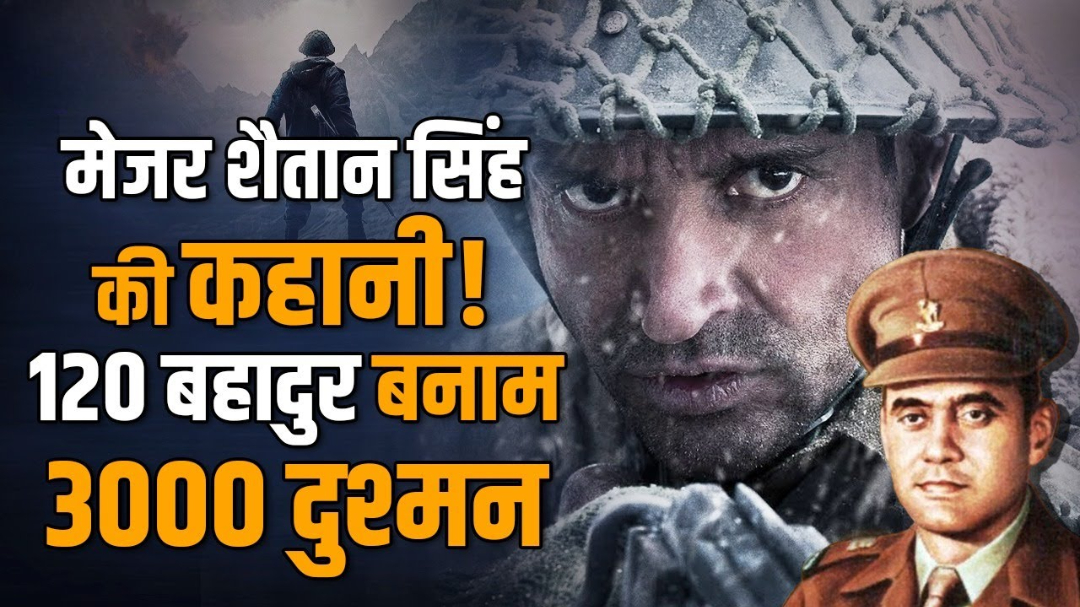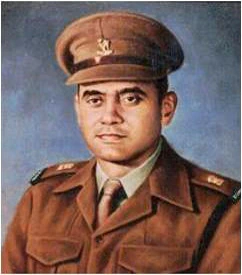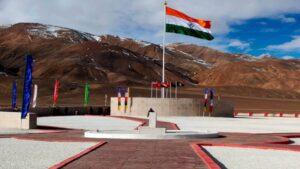
The Legendary Battle of Rezang La: When 120 Bahadur Defeated 3,000 Chinese Soldiers
Even though they had the chance to retreat and roll down the ridge’s rear slopes and spare their lives, these brave Ahirs held their ground until the very last man, final round, when the Chinese launched an overwhelming onslaught and death was scrawled everywhere. “No, that is not what they did,” said former Lieutenant General DD Saklani. Major Shaitan Singh Bhati, who was leading the Indian forces in the Battle of Rezang La during the 1962 India-China War, was last addressed by Lt Gen Saklani. The People’s Liberation Army (PLA) of China invaded with 3,000 men, and 120 Indian soldiers engaged in one of the greatest final stands in military history.
Major Shaitan Singh Bhati, who commanded the gallants at a height of 5,000 meters in sub-freezing temperatures during the Battle of Rezang La, was posthumously given India’s highest wartime bravery medal, the Param Vir Chakra, for his ultimate sacrifice.
Few conflicts in India’s contemporary military history can compare to the unadulterated bravery displayed by Indian soldiers at Rezang La, a mountain pass in eastern Ladakh. Only 120 troops from Charlie Company of the 13 Kumaon Regiment of the Indian Army repelled a 3,000-strong PLA invasion force in November 1962, despite temperatures as low as -40 degrees Celsius.
Dead Jawans were discovered in the trenches still clinging to their guns on a subsequent visit to Rezang La. All the men in this company were discovered dead in their trenches, suffering from multiple splinter wounds or gunshot wounds. Still holding a bomb, the man with the 2-inch mortar perished. The retired Major General Ian Cardozo subsequently reported that the medical orderly was carrying a bandage and a syringe when the Chinese bullet struck him.

Major Shaitan Singh Bhati’s body was flown to Jodhpur, where he was cremated with full state honours. (Image: Gallantary Awards Website)
The Indian jawans, primarily from the Ahir community of Haryana, held the strategic pass under the leadership of Major Bhati using only their guns, grenades, and unadulterated bravery.
The majority of the 110 slain soldiers were discovered frozen in their trenches, still brandishing their guns, having battled till the very end. By their bravery, the 120 bahadur (bravehearts) stopped the Chinese assault, preventing the Chinese from seizing the Chushul airport and further occupying Ladakh.
Such stories of valour and national duty don’t require an occasion to be told, but Farhan Akhtar’s recent film, 120 Bahadur, provides yet another cause to commemorate the Rezang La valour. Major Bhati and his 120 valiant men are shown in the teaser against thousands of Chinese forces in the frigid Himalayan highlands.
The film’s trailer, which was released this week, vividly depicts the timeless tale of the sacrifice made at 5,000 meters in the frigid desert, complete with hand-to-hand fighting and the suffering endured by the families left behind. The movie 120 Bahadur, starring Farhan Akhtar as Major Bhati, is scheduled for release on November 21.
The background and circumstances of how and why China and India were lured into the brutal conflict in 1962 must be examined before delving into the Battle of Rezang La’s narrative.
HOW CHINA CAME TO INDIA’S DOORSTEP IN 1962
Prior to the 1950 annexation of Tibet by Mao Zedong’s Communist Republic, India and China did not share a continuous border after independence. Tibet acted as a barrier for centuries, but during the occupation, Chinese forces were stationed right outside India.
China and India signed the Panchsheel Agreement in 1954. They pledged to live in harmony. However, by 1956, China had started building the Aksai Chin Road, which would connect Tibet and Xinjiang via Aksai Chin, which was and still a crucial portion of India.
China reacted violently when India objected to the route. Aksai Chin and sizable portions of the North-East Frontier Agency (NEFA, present-day Arunachal Pradesh) were depicted as Chinese territory on Chinese maps by the late 1950s.
In 1960, India responded by implementing a Forward Policy. In the frontier regions Beijing claimed as its own, it set up stations. New Delhi wanted to show its dominance without starting a conflict. However, this was viewed as provocative in China.
When China attacked NEFA and Ladakh at the same time in October 1962, tensions reached a breaking point and the India-China War broke out.
Indian forces were taken off surprise since they were outnumbered and ill-prepared. The combat at Rezang La in the southeast of the area was made possible by Chinese forces taking control of multiple Indian outposts in Ladakh by the end of October.
HOW INDIAN RESISTANCE WAS PRESENTED IN THE REZANG LA SECTOR
With a height of more than 16,500 feet (5,000 meters), the Rezang La mountain pass is a part of the broader Kailash Range, which provides a strategic view over the Chushul Valley. It developed into an important area of Ladakh, complete with an airfield that was essential for Indian soldiers’ reinforcements and logistics.
Indian soldiers reorganised their fortifications around Chushul in early November 1962 when China halted attacks in its western sector. As part of the 114 Infantry Brigade under Brigadier TN Raina, the Indian Army’s 13 Kumaon Regiment—which was mostly composed of Jawans from the Ahir community from Rewari in Haryana and the surrounding areas—was stationed at Magar Hill and Rezang La.
With just 120 troops, Charlie Company (C-Company), commanded by Major Shaitan Singh Bhati, was entrusted with holding Rezang La without the aid of armour, artillery backing, or proper winter gear. However, their bravery, unity, and unwavering faith in their commanding officer, Major Bhati, more than made up for their lack of equipment.
As the 120 Bahadur vowed to fight to the very end, to the very last man, the war cry of Dada Kishan ki Jai reverberated high in the bitterly cold Himalayas.
THE 1962 WAR’S TACTICAL WIN IN THE BATTLE OF REZANG LA
Although Rezang La was an important fight, it was not a lengthy one in terms of days.
The Rezang La was taken by the PLA on November 20, but the Chinese lost the war. The PLA’s assault had been slowed down and a wider incursion into Ladakh had been avoided thanks to the 120 bahadur.
The loss of hundreds of troops to Major Bhati’s forces was a psychological blow notwithstanding their numerical and logistical advantage. The very following day, the Chinese stopped their assault, and on November 21, they unilaterally announced a truce.

The Rezang La War Memorial in Ladakh, standing tall at over 4,500 metres, honours the bravery of the 13 Kumaon Regiment in the 1962 India-China War. (AFP Image)
Rezang La was a tactical triumph, but in the wider 1962 War, India had suffered a strategic defeat. It proved that Indian soldiers made up for their lack of essential weaponry and ammunition with bravery and determination.
India’s highest wartime heroism medal, the Param Vir Chakra, was posthumously given to World War II veteran Major Shaitan Singh Bhati.
For their bravery, the 13 Kumaon Regiment was awarded the Theatre Honour Ladakh and the Battle Honour of Rezang La. Its troops received four Sena Medals, eight Vir Chakras, one Ati Vishisht Seva Medal, and one Param Vir Chakra (Major Shaitan Singh).
The Charlie Company was renamed the Rezang La Company and re-raised in 1963.
The Rezang La War Memorial was built in 1963 in the Chushul Plains, directly on the Indo-China Line of Actual Control, at a height of more than 4,500 meters. A refurbished memorial to the Battle of Rezang La was unveiled at the same location in 2021 by Defence Minister Rajnath Singh.



